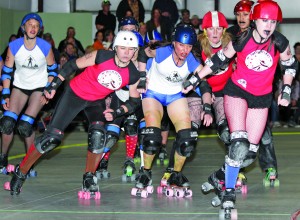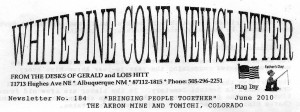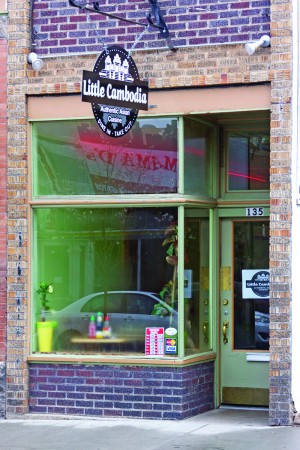By George Sibley
So America, how’s that tightey- whitey Tea Party workin’ out for ya?
I have to ask – but I’m kind of embarrassed by the question. It just shows I’m infected by the same semi-focused anger and frustration as the rest of the dying American middle class. I’m just coming at it from another angle than the angry, frustrated people whose inept response was the misbegotten Tea Party.
I’m actually as horrified as I’m angered, horrified at how totally aggressive and vicious the assault on the middle class has become – the fact that we are now quite openly taking away from the poor in order to protect the ultra-rich. Never before has the grasping insatiability of those for whom there is never enough been so naked. But even more horrifying is the avid and aggressive participation of so many middle-class people in the undermining of themselves and their future. To see anything comparable, I think we have to go all the way back to the 1930s in Germany, when Hitler was seducing the German bourgeoisie into surrendering their minds to “Make Germany Great Again.” My anger gets evenly split between the exploiters and the exploited, the suckers seduced into doing the dirty work against their fellows – and it is a smoggy unclean anger because I don’t have any idea what to do about it. It is truly as Yeats said: “The best lack all conviction, while the worst are full of passionate intensity.” I’m as angry at myself as at “them” for my lack of knowing what to do.
But now I’m puzzled too, because of a story that has been tapping me on the shoulder recently – a story I have never been able to either really understand or forget, one of those “once and future” stories we carry forward because we’re still looking for the frame of reference, the context into which they fit.
It’s a story Emil Lunk told me 40-some years ago in Crested Butte about a coal strike 80-some years ago. Emil was a German immigrant who came to America in 1927. A decade earlier he’d been fighting for the Kaiser, and I remember thinking – still do – that it was a brave thing, to come to a new land to work among people who knew you’d been trying to kill them fairly recently. Maybe it was just a desperate thing – but desperation doesn’t preclude courage.
At any rate, he found his way to Crested Butte, where he said he had been told “the streets run with milk and honey.” God knows where that came from. Crested Butte was a coal-mining town with 100-plus coke ovens, not to mention several hundred coal-fired cooking and heating stoves in uninsulated buildings, so no one could have mistaken the snow for milk (or the yellow snow for honey).
But Emil’s arrival, in November 1927, coincided with a big strike. The Wobblies – the dreaded commie International Workers of the World – had taken all the coal mines in Colorado out on strike for labor’s Big Three: the eight-hour shift, safer working conditions, and better wages, in about that order.
But imagine Emil’s dilemma; a stranger in a strange land, broke after steerage passage on a rag-ship and train fare to Colorado, winter setting in, and he was at the literal end of the line in a place with no work.
But the strike that winter in Crested Butte took on an unusual dimension. Crested Butte coalminers then were (like Emil) primarily first-generation immigrants from south and central Europe – Croatians, Slovenes and Italians. They were almost all peasant refugees from the ongoing capitalistic enclosure of the old feudal commons of Europe. It was in their cultural blood to grow and put up food – and American wages encouraged continuing that. They didn’t have yards in the conventional American sense. They had fenced gardens with chickens running around eating bugs and spreading fertilizer, and a pigpen in one corner where they fed a spring piglet on garbage all summer and butchered it in the fall. A truck went over to Paonia every fall for a load of apples; a traincar of grapes would show up, Prohibition notwithstanding, all of which would mysteriously disappear overnight. There were some small coal mines in the valley that worked out a local deal to supply the townspeople through an operation that could either be called communistic or communal, depending on your economic religion. So by November, with food and drink and fuel put up, the Crested Butte miners were as ready for a long hard winter as people can be.
For men used to working underground from before dawn till after dusk in winter, six days a week, and for wives and mothers freed up from the mountains of coal-loaded work clothes to wash, it was a chance to stand up, or sit down, and take a look around. And there was time to do what came either naturally or culturally to these European refugees, and that was build some community around the philosophy that we’re all in it together. They had fraternal unions that gave English lessons to the adults and native-language lessons to the kids – half into assimilation and half into keeping their culture alive – and those were also places to meet, talk, drink (soda pop of course), dance and otherwise practice their philosophy.
That was where Emil Lunk found his niche. His biggest piece of baggage from Germany was a bandonium, a button version of the accordion, and he played the hell out of it. He discovered that there was a party or a dance somewhere nearly every night – what else was there to do? “Will play for food,” might have been his motto, or maybe “will play for life.” He found a bar where he could play in exchange for a room upstairs.
I don’t want to romanticize that winter, and Emil’s experience. It was a hard time, harder than most winters because there really was not much money around – practically none by winter’s end – and life in America without money is basically cold and brutal. And in the spring, all the miners went back to work under practically the same working conditions, with only a very small wage increase. The strike had – like most strikes at that time – failed to change much. But the presence of each other, the store of food and drink (not abundant but sufficient), and a heritage of making their own music and dancing to their own tune, made it a lot less cold and brutal than it might have been, less than it was in some other Colorado coal towns that year.
(I will note that they had their “tightey whiteys” too. Through most of the 1920s, the Ku Klux Klan reigned in Colorado, and they rallied once in Crested Butte – just once – to remind that townful of immigrants who was in charge. They lit a cross on the bluff west of town – but their march back through town turned into a rout; the townspeople just wouldn’t cower like they were supposed to, and the tightey whiteys’ sheets got a little dirtied and bloodied.)
Emil didn’t draw any moral to his story when he told it to me, and I’m not going to try to draw one now, but there’s some context I’ve been thinking about. Colorado’s coal-miners in 1927 couldn’t know it, but the plutocrats of their day were about to blow it – grab too hard for too much. Within a decade, the miners and everyone else who worked in industrial America would have collective bargaining rights, and a government looking out for their health and safety as well as for the profitability of their employers. They would have the promise of a little income when they were too old for the heavy lifting. The middle class was forming – and grew mightily after World War II. By the time I came into political consciousness, it seemed like expanding the middle class was the true work of America.
So what has happened? The re-emergence of the plutocrats we should probably have foreseen. Like the poor, they shall always be with us (and not coincidentally). But why has that middle class hatched a Tea Party that wants to collaborate with the revived plutocrats to undo itself, to restore the old medieval class system of aristocrats and chattels?
But there is another twist to this that I have to figure out. I didn’t find myself in Crested Butte 45 years ago because I wanted to expand the middle class. In fact, I was pretty much in flight from the American mainstream and what I called its materialism and militarization.
I also didn’t know how to dance, the way men dance, and had no idea what a “community” was. The middle class I had grown up in was forgetting its basic philosophy: that we’re all in it together. Emil and those old coal-miners invited us into their community, taught us to dance – and told us forgotten stories from the far edge, the “prequel,” of the incipient middle class. That has something to do with the importance of Emil’s story to me, a naïf from what may be the last chapter of the middle class. I’ll keep working at figuring it out, like a dog working at a bone – while the plutocrats and their Tea Party toadies keep working away at repealing the middle class.




Thank y0u for your observations, George. In Colorado, where the culture is very “white bread” community is an important aspect of the new paradigm that needs to be developed here.
Emil’s story is an important chapter, one we should remember as the bills pile up and the plutocrats take away those few things we were allowed to gather before that Fall of 2008.
And gather round the fire and tell our daughters, and our sons, of those days when it was, perhaps, a little more obvious what was going on. The story doesn’t really change all that much, but the players get a little better at hiding their ways (behind, ahem, gated communities down here in the lowlands where I now serf).
Keep writing, George. We treasure your gift.